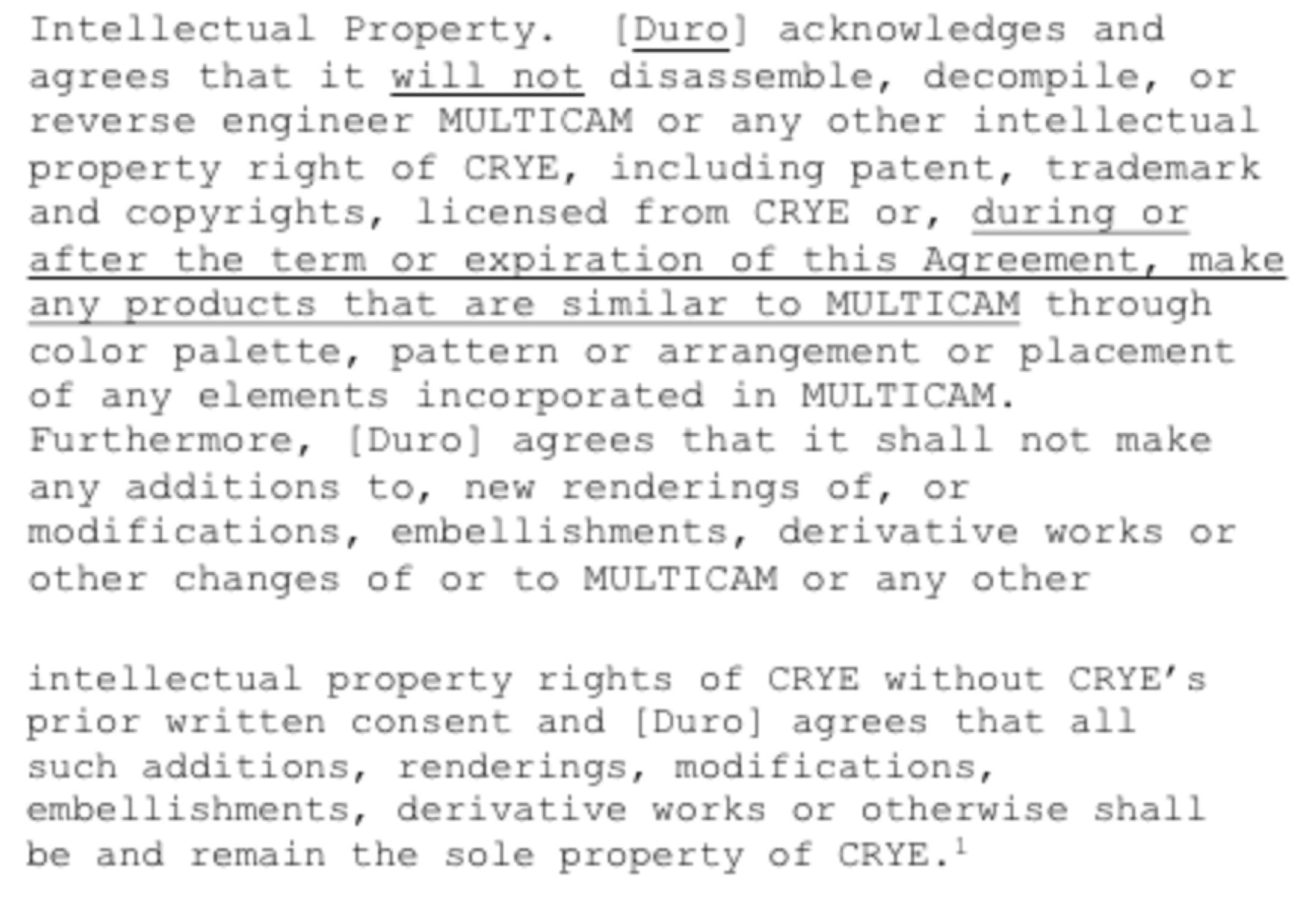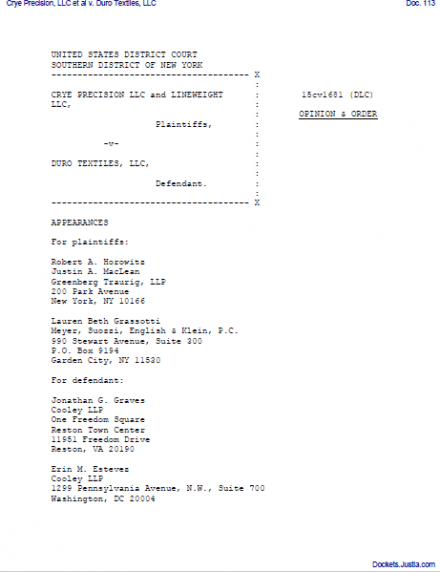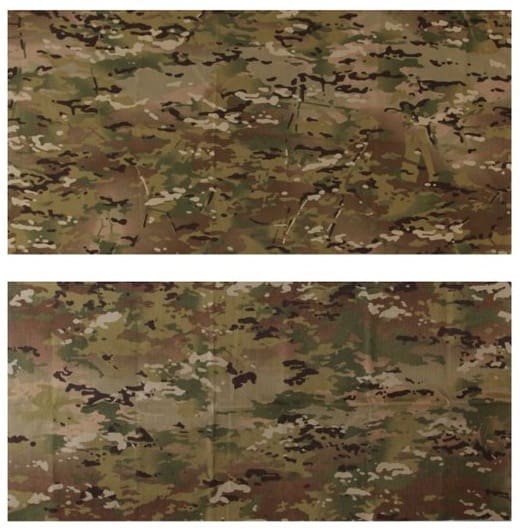On Friday, 22 April, 2016, Federal Judge Denise L. Cote published a ruling, granting Duro Textiles motion for summary judgement and dismissing with prejudice Crye Precision’s remaining claims against Duro Textiles, stemming from a lawsuit filed against Duro in early 2015. This is actually a second lawsuit although the initial suit was filed in late 2014 and withdrawn in early 2015.
Specifically, the Judge dismissed three specific allegations in this suit; breach of contract, trade dress infringement and common law unfair competition arising from Duro’s printing of a camouflage pattern owned by the US Government.
Crye Precision’s MultiCam licensing agreement was central to their claims against Duro. Duro last signed such an agreement with Crye in 2012 and once it had expired in 2014, and Duro began printing the Army’s OCP, legal actions commenced.
Below is the paragraph 3(h), in question.
According to New York law, this clause from the 2012 agreement is unenforceable due to reasons stipulated in the ruling. Furthermore, the judge ruled that it was too broad in scope. At face value, it seems like a pretty straightforward ruling by the court, until you consider that it could create a situation where the premise it is based upon fundamentally changes. The full order, seen below, is quite detailed and worth the read.
To be sure, this is a victory for Duro, but perhaps a bittersweet one. Duro was essentially a lone horse in printing OCP for the Army. Now, they are sure to see competition for this business in the future. What’s more, the Army may well lose control of the pattern it created for use in place of MultiCam. Whether the Army likes it or not, we may see commercial OCP, or really close copies, by Christmas.
Here’s why. Much to the chagrin of those of us watching from the sidelines, the Judge’s decision does not declare whether MultiCam and OCP (Scorpion W2) are similar. Rather, the court is very clear that Duro is just printing what the Army paid them to print; namely, OCP and claims that the government can tell the difference.
Judge Cote dismissed Crye Precision’s claim of trade dress infringement. The court’s ruling may well have set creating about an interesting situation. Consider this:
The Government is the creator and only purchaser of Scorpion W2. It is a sophisticated consumer, as its creation of Scorpion W2 and its announced switch from MUTLICAM in 2014 evidences. Duro’s only sales of Scorpion W2 have been for the Government, specifically to Government contractors and subcontractors in the supply chain for the U.S. Army. These contractors order Scorpion W2 from Duro by name. Thus, while MULTICAM and Scorpion W2 compete in the same Government sales market, there is no likelihood of actual confusion on the part of the Government or its contractors.
It’s the second and third order, or should I say “disorder” effects that will be interesting. For example, what if the consumer is no longer just the US Army but also commercial customers. Could that expanded consumer group tell the difference between these two patterns?
This exact situation may be additional fallout from this ruling, and it may not just affect Crye Precision. By declaring the competition clause of Crye’s licensing agreement void, could printers, licensed or not, begin to make counterfeit versions of MultiCam, or for that matter OCP, consequence free?
Although Judge Cote declared the provisions of Crye Precision’s licensing agreement too broad, you have to wonder how specific they would have to be to satisfy the court and protect the pattern(s). As far as I know, current licensees are under a newer 2014 version of the contract which may contain updated language that already addresses the court’s concerns and were signed under different circumstances than the long-standing agreements with Duro. It must be noted that this ruling by Judge Cote is specific to the situation with Duro.
It is yet to be seen whether Crye Precision will appeal the ruling, but it doesn’t stop them from defending their IP on other fronts. Also, although many are concerned with license fees for the printing of both MultiCam and OCP. This ruling doesn’t address them. Regardless, the bottom line here is that Crye is going to have to sue the US Army if it wants to ultimately settle the MultiCam vs OCP question. We’ll keep you posted if we hear anything.
Tags: Crye Precision, Duro Textiles





Was wondering how this was going to turn out. Figured it would be this way since Duro did not reverse engineer MultiCam but simple started printing OCP which was owned by the ARMY. So I wonder if this means MultiCam will continue to be printed at Brookwood. They have always been good to us.
Hah. The judge wrote “…Clothing and Sales stores…”. I guess Her Honor just made an official ruling. (chortle)
No, she just quoted what someone at Army PAO wrote.
It took about 6 months for a commercial MTP pattern to appear, with only slight color change its a different pattern not owned by the MOD and available for kit makers
The CP licensing agreement kept this from happening in the US. Now, we’ll see.
I’d still like to see Crye’s pattern they submitted for the camo trials.
yeah its called Multicam
Multicam was the base pattern. The submitted camo pattern was different
Weren’t MC tropic and arid slightly modified versions of the patterns Crye submitted? Or were there plans to release those regardless?
It is my understanding that they are modified versions of the Phase IV submissions but we went over this year’s ago when they came out.
That is what I thought… I meant to reply under Mike’s reply, not directly below it.
What does this mean for bookend patterns?
Lol…
so what did happen to the bookend patterns??
So I can finally see HH6 in Victoria’s Secret Multicam by Crye?
I am failing to see how this is a bad thing…
Multicam sheer fabric…….mmmmmm…….
It means that Crye’s intellectual property is more at risk for counterfeiting. So maybe it’s not so bad for you and the Victoria’s Secret catalogue, but it puts a part of Crye’s livelihood at risk
When I look at Scorpion W2 and MultiCam side-by-side I see two patterns that are clearly different, but at the same time vaguely similar – like children born of the same parents…
What would settle the whole debate once and for all would be to see a detailed summary of who initiated the development of the original Scorpion pattern, who owned the rights to it, and how Crye Precision then went on to further modify it into ‘MultiCam’….
I’ve always understood that ‘Scorpion’ was created by Crye under contract to Natick – so Natick / US Army owned the rights to it – but that Natick / US Army then allowed Crye to work on it further on their own to create MultiCam.
Is that not correct?
I believe that Crye just made what they consider a new pattern (MultiCam) using what they learned from making the original Scorpion. I don’t think they were necessarily “allowed” to do it. They just did. Looking at the two different patterns I don’t see any issue with it. But nobody asked me. Everything I have just wrote is what I think. Don’t be taking it to the bank.
https://soldiersystems.net/2014/09/22/crye-precisions-scorpion-contract-calls-into-question-army-claims-of-appropriate-rights/
Thanks for the reminder about that piece you did on that a year and a half ago.
Forgive me for asking, I’ve not had time to read th whole contract proposal, does Crye at some point in there actually specifically refer to or show an image of a particular pattern, or do they only refer (vaguely and broadly) to ‘novel camouflaging technologies’?
‘Novel camouflaging technologies’ covers a pretty broad spectrum of possibilities…. And of course lawyers just LOVE vague language in contracts. 😉
Mostly like pron. You know it when you see it.
And while lawyers love vague language because it keeps the lights on, the people they’re apprenticing to become (judges) HATE it when they have to make a ruling that history may regard as a WTF moment.
It was a development contract. They didn’t show photos for diagrams of any of technologies already developed in-house when they signed the contract.
Thank God this was resolved….now the chances of someone showing up to the ball in a similar dress will rise drastically….heads all over the debutant world are about to explode.
Crye milks their patent for all that its worth-and good for them.
They shouldn’t be surprised when someone bellies up to the fringe of their patent claims and sets up shop.
So, since the Army owns the Scorpion pattern, if Duro started manufacturing it for the civilian market then wouldn’t the Government sue Duro for breach of contract? It seems as though it would be rather stupid for Duro to screw up good money from the Government by trying to sell Scorpion on the civilian market. The Crye VS. Government side of things seems a little more convoluted and beyond my limited understandings.
Well, to my limited legal understanding, intellectual property owned by the US Government is, by definition, public property. Therefore (it seems to me), unless otherwise encumbered by something like being Classified security information, government “owned” intellectual property is in the public domain and wide open for all comers to use in any lawful manner whatsoever.